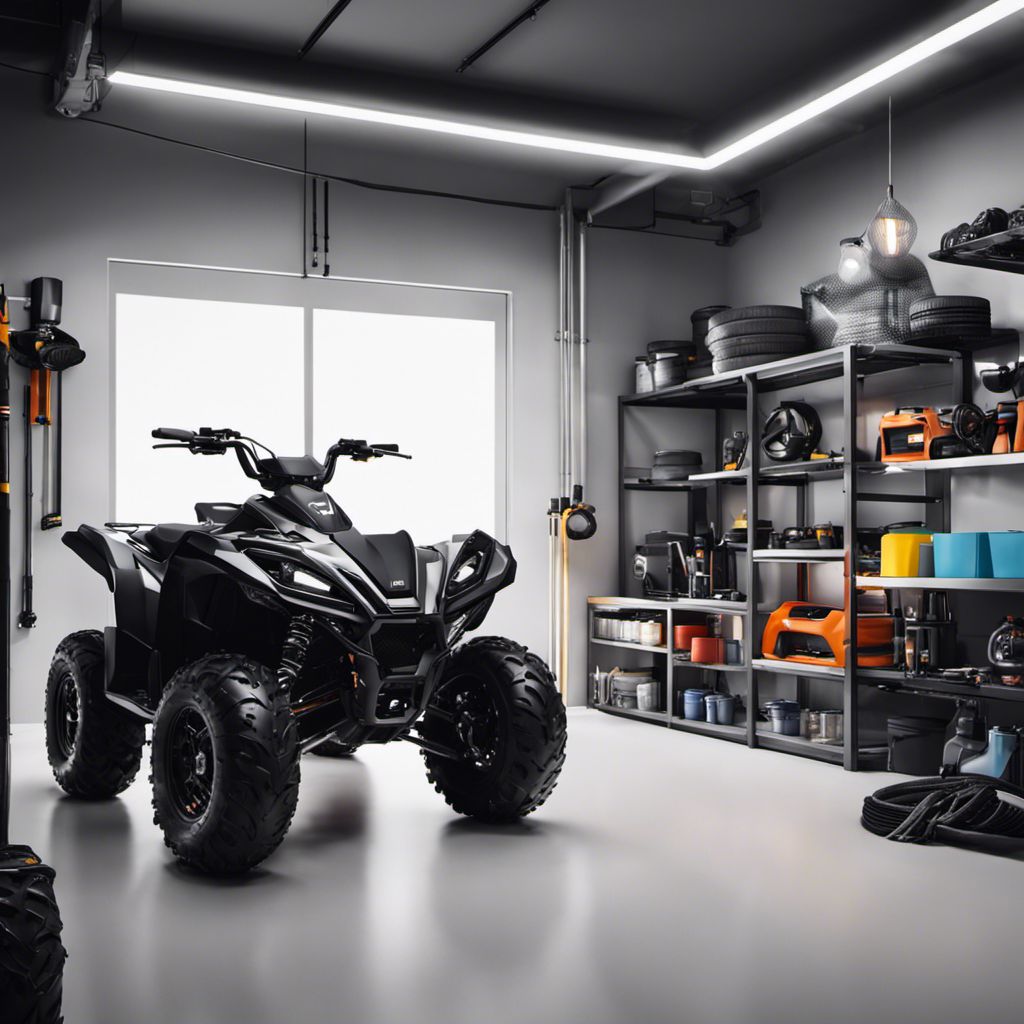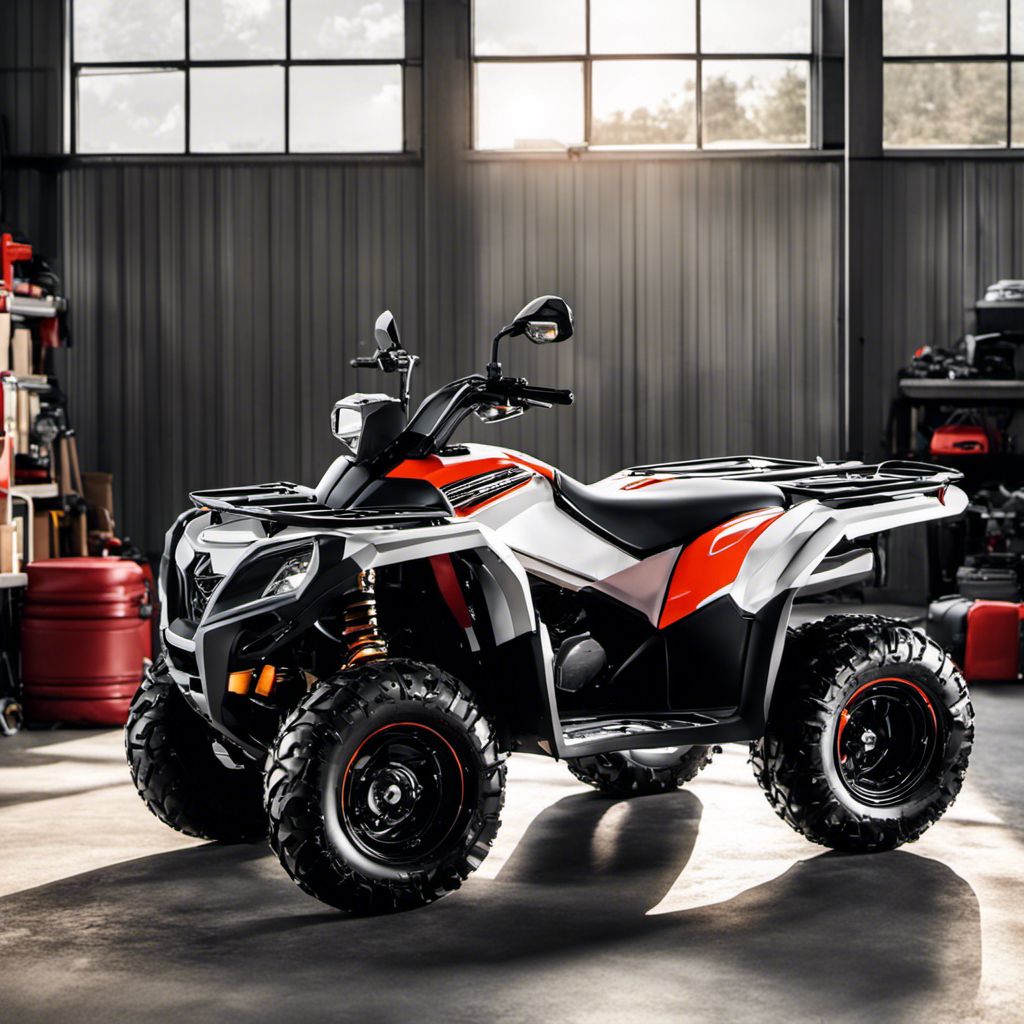Everyone agrees that there is a unique excitement in speeding down a trail on your ATV, feeling the breeze as you tackle the toughest terrains Mother Nature has to offer.
But in an instant, this adrenaline-pumping thrill can be brought to a screeching halt by unexpected hitches with your ATV’s suspension system. As fellow off-roaders who have tasted that bitter pill of inconvenience more than once, we’ve dedicated countless hours researching and learning how best to keep our ATVs running smoothly.
And guess what? Regular inspection and maintenance emerged as undisputed game-changers.
In this blog post, we’re going beyond sharing; we’ll guide you through a comprehensive step-by-step tutorial on ATV Suspension System Maintenance. With our help, your ride will effortlessly glide over bumps and withstand harsh terrains with enviable ease.
So if you’re ready for smoother journeys and less downtime wrenching in the garage – let’s dive right into it!
Key Takeaways
- Keep your ATV clean and check it often. Watch the tires, rubber parts, oil levels, and battery.
- Check all fluids in your ATV. Follow the fluid guide from the maker of your ATV.
- Care for your tires. Look for cuts or holes and keep them at right pressure.
- Inspect front to back of your ATV often. Pay close attention to rust and loose pieces.
- Look after engine parts like oils, coolant, spark plugs, air filter, and battery.
- Put on lubricant regularly on suspension system as told in user manual.
The Basics of ATV Maintenance

Just like any vehicle, your ATV requires consistent care and attention – this includes routine cleaning and thorough inspections, regular checks and changes of fluids such as oil or coolant, and diligent tire maintenance to ensure a smooth ride every time.
Regular cleaning and inspection
We all know that regular cleaning and inspection are key for ATV upkeep. Here’s how to do it right:
- Start with routine maintenance. This includes washing off all dirt and mud from your ride. Don’t forget to cover sensitive areas before spraying water.
- After cleaning, do a visual check of the whole ATV. Look at both the front and back parts of the vehicle.
- Pay close attention to the tires during this visual exam. Ensure they’re in good shape and free from cracks or tears.
- Also, inspect all rubber parts closely for any signs of wear or damage.
- Make sure to check the ATV’s oil levels regularly, too, and change when needed.
- Complement this with battery inspections on a routine basis as well.
- After every 50 hours or after riding around 300 miles/500 km, inspect your machine’s brake system and drive train.
Fluid checks and changes
Taking care of fluid checks and changes is high up on our ATV maintenance list.
- We always watch for the ATV’s fluid levels. It tells us if anything is not right or needs more attention.
- Regular fluid checks keep our ATV running smooth and safe. We never miss this step in our routine.
- The manufacturer’s fluid guidelines are there for a reason. They help us know when to change or fill the fluids in our ride.
- Keeping track of ATV fluid maintenance gives us peace of mind. We know we are doing what is best for our machine.
- Fluid change recommendations are not suggestions, they are must – dos! Following them adds life to our ATV.
- We make sure to follow the right steps in fluid filling instructions accurately each time.
- Changing fluids often might seem like too much, but it’s not! In fact, regular fluid change frequency keeps us from unwanted breakdowns.
Tire maintenance
We always keep our ATV tires in top shape. Why? It makes our ride safe and fun! First, we check tire pressure often. Right pressure means a smooth ride. If the lug nuts are loose, we tighten them up right away.
We also take a good look at all rubber parts for cuts or holes. Keeping an eye on these things helps find damage early. Plus, it lets us stick to the guidelines in our ATV manual for best care practices.
Tips for Efficient ATV Maintenance

We always recommend following the manufacturer’s guidelines when it comes to maintaining your ATV. It’s also a good idea to keep detailed records of all maintenance tasks, as this can help you track wear and tear over time – ensuring that your ride remains in top-notch condition!
Follow manufacturer guidelines
Always use the ATV maker’s rules when fixing your ride. These guides are created by experts who make these machines. They know what works best for each model and type of ATV. It helps to keep your machine in tip-top shape and can prevent big problems down the road.
Using these guides also makes sure any repairs or changes you do won’t harm your ride, or worse, void a warranty if something goes wrong.
Using the manufacturer’s guide as our bible also ensures we don’t miss out on small maintenance tasks that lead to bigger issues later on, like checking tire pressure or cleaning air filters regularly.
Ignoring this can cause damage to your ride. Our aim is always to be safe and have fun with our ATVs!
Keep records for maintenance
We must always keep good records for our ATV maintenance. This means writing down when and what work we do on our ATVs. Hold onto those receipts too! They show the work was done right.
Good records help us know when to do more checks or fixes.
Our ATVs run better and last longer with this record keeping. A well-kept log helps in scheduling future care tasks, like a detailed inspection or fluid change. It’s part of effective maintenance that leads to better performance and riding fun for years to come.
Step-by-Step ATV Suspension System Inspection Guide
Kickstart your hands-on experience with our detailed guide, taking you through the necessary steps in performing an ATV suspension system inspection. From conducting a thorough visual examination of both front and rear parts of your vehicle to deep-diving into components like wheels, brakes, shock absorbers, and radiator – we’ve got it all covered for you.
To ensure optimum performance and longevity, don’t miss out on examining engine essentials like oils, coolant, spark plugs, air filter as well as the battery. Remember that regular lubrication forms a pivotal part of maintenance; it helps extend the life span of moving components by reducing friction and wear.
Get ready to roll up those sleeves; we’re diving into some serious yet rewarding ATV maintenance tasks next!
Visual inspection of front and back of vehicle
Let’s start our ATV check from the front to the back. First, we eye the bushings for any damage. We pay close attention to rust on fastening hardware and suspension parts. Spotting these signs of wear early helps keep our ATVs in top shape.
Next, we inspect all parts of an independent rear suspension. If there is a picture on your ATV manual cover, it may not look like your ATV model but don’t worry! These checks work for most ATVs out there.
We also search for cracked or loose pieces in the suspension system during this visual sweep. This is very important because such issues can hurt how well our ATV works and its lifespan too.
Remember, every part of this process aids us to prevent problems before they become big ones so that we can enjoy safe rides over many fun-filled weekends!
Checking radiator, wheels, brakes, shock absorbers, center of vehicle
We start by looking at the radiator. Make sure it’s free of dirt and bugs. If anything is stuck, wash it off with a hose. Next, we check the wheels. Are they in good shape? They should not have cuts or bulges on their sides.
Brakes are very important too. Check that brake pads are thick enough and that there isn’t any rust on them. We also need to see if the brakes work well.
Shock absorbers help your ATV ride smooth and steady even over bumpy land. To know if they’re okay, push down hard on each corner of your ATV – front and back – one by one; for each push, the ATV must rise back quickly.
Finally, we look at the center of your vehicle for oil leaks or loose parts that you might find stuck around chains or axles after a long ride.
Mechanical inspection of engine, oils, coolant, spark plugs, air filter, battery, etc.
Let’s dig into the guts of your ATV – we’re talking about the engine, oils, coolant, spark plugs, air filter, and battery. These parts need a good look at least once in a while. We start with the engine.
It should be clean and free of leaks. No strange sounds should come from it when running.
Next up are oils and coolants. Both have to be fresh and full for an ATV to work well. Low or dirty oil can harm an engine fast! Coolant keeps everything inside your vehicle nice and cool on hot days.
Spark plugs also need attention during inspection. They make sure that fuel burns right in an engine. When they are dirty or worn out, replace them with new ones.
Now let’s talk about air filters and batteries too! A blocked air filter will stop needed oxygen from getting into your vehicle’s engine which could lead to big problems later on! And don’t forget about checking the battery as well! If it is weak or dead then all other checks might not help much since you won’t even be able to start your machine without it!
Importance of regular lubrication
Lubricating your ATV’s suspension system should be a habit. This task is key for safe rides and keeping your vehicle in top shape. The user manual has a schedule to guide you. It tells you when to do it and how often.
Each part of the ATV needs care, especially the suspension system. Use lubricant on it regularly to keep it working well. This helps the ATV live longer and perform better out on trails or on race tracks.
Conclusion
Taking good care of your ATV is a must. It keeps your ride safe and fun. Always check your suspension system well. This guide can help you stay on top of it all.
FAQs
1. What is the purpose of ATV suspension system maintenance?
ATV suspension system maintenance ensures a smooth, safe ride by checking for worn-out or damaged parts.
2. How often should I inspect my ATV’s suspension system?
It is good to check your ATV’s suspension system after each ride, but a thorough inspection should happen at least once every year.
3. Can damage happen if I don’t maintain my ATV’s suspension system?
Yes, not maintaining your ATV’s suspension can lead to major damages that risk rider safety and require costly repairs.
4. Is it hard to perform an inspection on an ATV’s suspension system?
While some knowledge is needed, following a step-by-step guide can make inspecting an ATV’s suspension easier.
5. What are the key parts of the ATV Suspension System that need regular checks?
Key parts needing regular checks include shocks, springs, control arms and all connecting bolts or joints.

